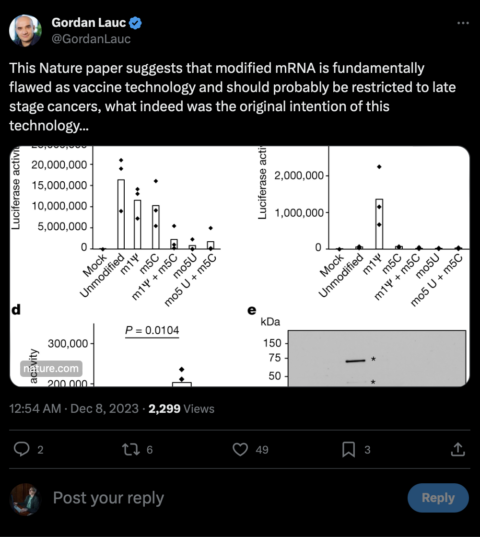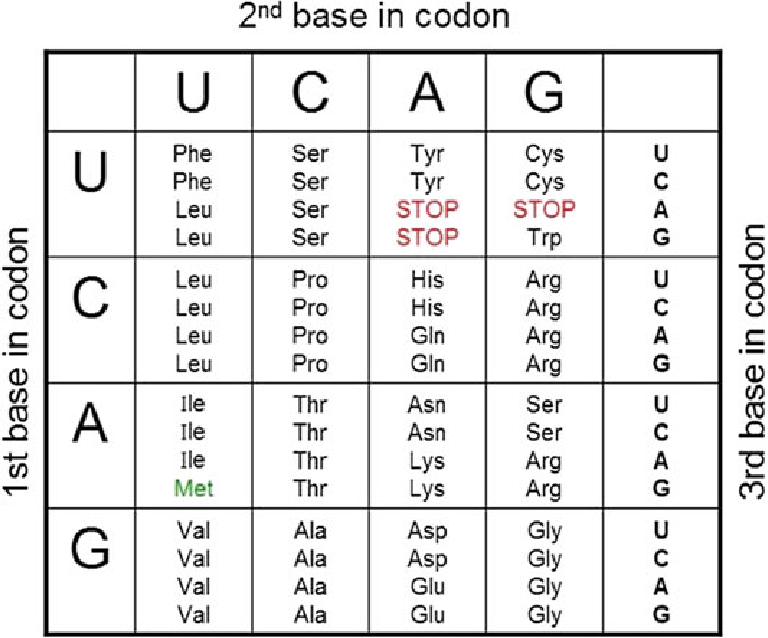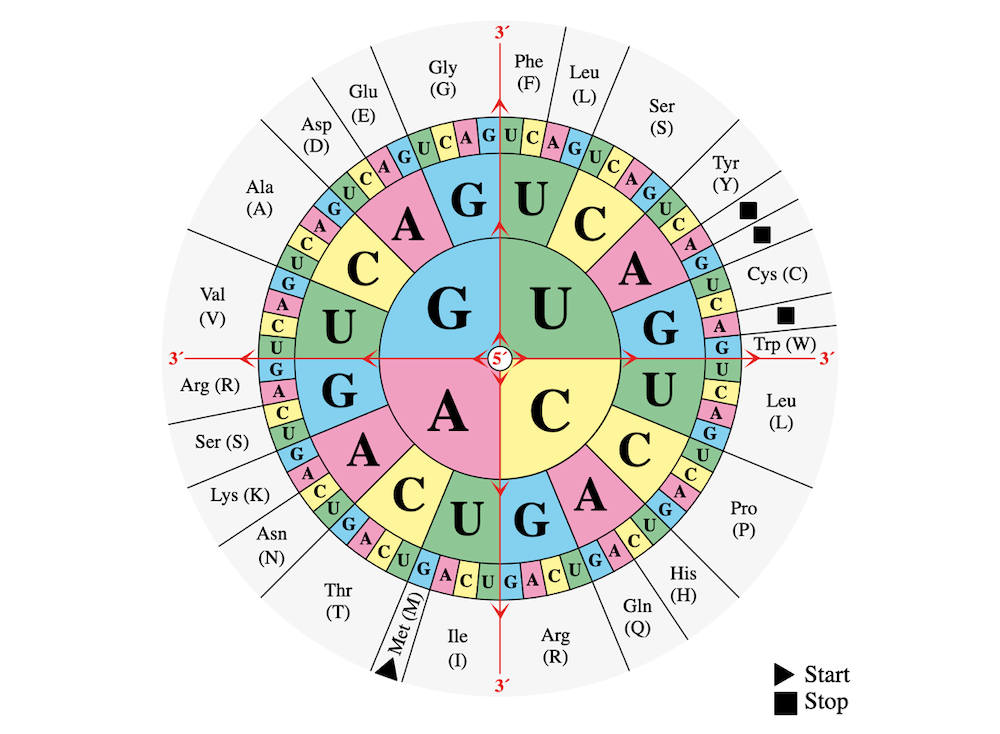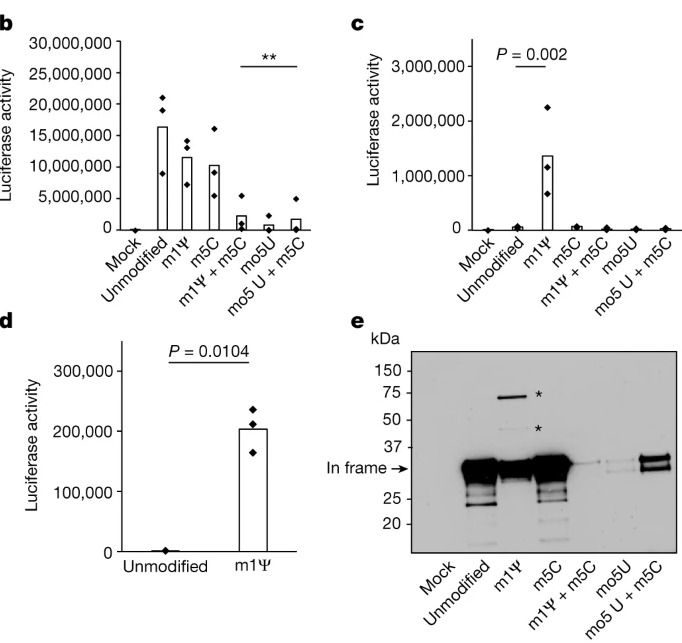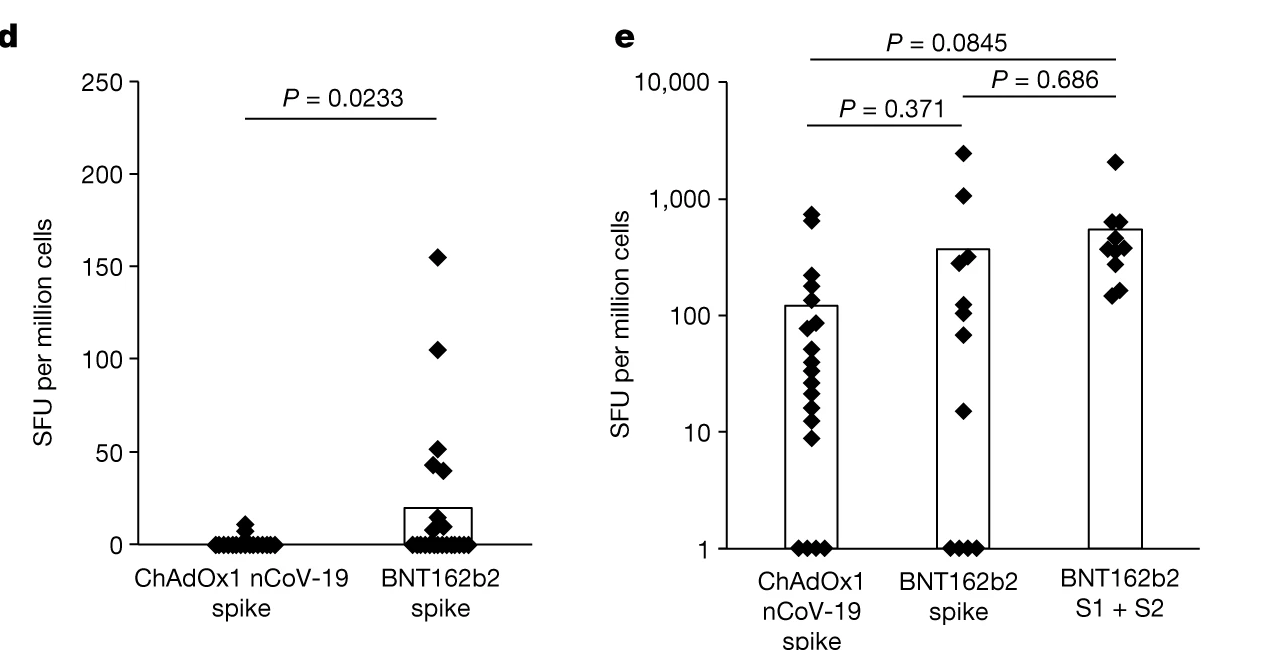One unexpected consequence of the infodemic of misinformation and disinformation that has accompanied the COVID-19 pandemic is that it’s given me a chance to reacquaint myself with some molecular biology and genetics that I hadn’t been using nearly as much, thanks to a chance in my research focus several years ago. My lab used to do experiments studying microRNAs and how they regulate gene expression. I even studied how transcription factors regulate gene expression and did a dissection of the functional domains of a transcription factor, but over time I’ve moved towards projects that involve more cellular biology and repurposing drugs approved for other indications for use treating breast cancer. Thanks to antivaxxers, though, I now get the opportunity to go back to my scientific roots, as when James Lyons-Weiler tried to claim that he had found plasmid sequences in the (then) newly-published sequence of SARS-CoV-2, the coronavirus that causes COVID-19, and that this was slam-dunk evidence that he had “cracked the coronavirus code” and proven that SARS-CoV-2 had been artificially engineered in a laboratory as the result a misadventure trying to produce a SARS vaccine. Let’s just say that a careful look at the actual sequences that he examined was not consistent with his conclusions. Then there were so many articles claiming that the mRNA vaccines “permanently alter your DNA” (they don’t) and that contaminating plasmid DNA with short sequences from the SV40 promoter from one of the plasmids used in the Pfizer manufacturing process were getting into the nucleus, inserting themselves into the genome, and causing insertional mutagenesis leading to cancer., (There’s no evidence that they do any of that.)
This brings me to just the latest example of the willful misinterpretation of molecular biology (along with some immunology).
Frameshifts and “junk proteins”: Let the fear mongering begin!
It was with quite a bit of interest that I started seeing articles on antivax Substacks hyping yet another dubious claim based on molecular biology designed to frighten people that somehow the modified mRNA used in the Pfizer vaccine was causing a frameshift (I’ll explain what that is in a moment) that led to the production of “random junk proteins” in addition to the intended protein product, the SARS-CoV-2 spike protein, that result in “unintended consequences,” I knew I had to read the study that antivaxxers were hyping. This was even more true after I ventured onto X, the platform formerly known as Twitter, and found posts like these:
“Despite their widespread use, surprisingly little is known about how ribonucleotide modification affects protein synthesis, particularly for translation of therapeutic IVT mRNAs.”
Excerpt from peer reviewed study published in Nature https://t.co/4NgcYhZ6G0
— Godefroid Chapelle (@__gotcha) December 9, 2023
Explain how the recent discovery that the mRNA injections create not just the spike but multiple unintended and unfiled exotic proteins is not grounds for an immediate FDA level 3 recall? https://t.co/RCfoGD90md
— Coalmine Canary (@CoalmineCanary9) December 10, 2023
This! 👇👀🔥 Unvaxed and proud of it! https://t.co/cTMmLlbFa1 pic.twitter.com/SJcrG8HxcC
— Pops (@UPMHPM) December 7, 2023
Some scientists have tried to calle BS on all the conspiracy mongering, but to little avail.
Unfortunately, though, the misinformation has gone beyond just spreading on antivax Substack, X, and other social media. There are newspapers promoting it as well:
BREAKING News about COVID vaccine safety!
A study just published in Nature reports that the mRNA shots cause the production of RANDOM, "nonsense" proteins in recipients one third of the time: https://t.co/O2NXjNRzInA Telegraph article for laymen is here: https://t.co/fgzXqnE7Hy
— Ned Nikolov, Ph.D. (@NikolovScience) December 8, 2023
The Telegraph, for instance, features this misleading headline, One in four who had Moderna or Pfizer Covid jabs experienced unintended immune response:
More than a quarter of people injected with mRNA Covid jabs suffered an unintended immune response created by a glitch in the way the vaccine was read by the body, a study has found.
No adverse effects were created by the error, data show, but Cambridge scientists found such vaccines were not perfect and sometimes led to nonsense proteins being made instead of the desired Covid “spike”, which mimics infection and leads to antibody production.
mRNA jabs, such as the ones created by Moderna and Pfizer, use a string of genetic material to tell the body to create a specific protein that safely imitates an infection.
In fairness, The Telegraph does include context from the scientists involved in this study, but there’s plenty in the story, like the above passage, for antivaxxers to latch onto—for example, the claim that one in four subjects suffer an “unintended immune response” is doing some very heavy lifting here, as you well see—even from the passage providing context:
In this scenario not only is the vaccine not making the right protein, it could lead to a rogue protein being produced.
There is no evidence of this occurring in the Covid jabs, the authors stress, and they say any trials on other mRNA therapeutics would detect any such problems in early stages.
The BBC was a bit more measured, using a more accurate headline, Covid study: mRNA vaccines could be fine-tuned:
The revolutionary messenger ribonucleic acid (mRNA) technology in some Covid vaccines given to millions of people could be fine-tuned for even greater accuracy, UK scientists say.
Genetic instructions in the jab could be tweaked to avoid a harmless tiny “slip” sometimes seen as the body reads the code, the Medical Research Council team suggest.
Existing mRNA vaccines are effective and safe, they say.
Future ones could fight more diseases.
Of course, antivaxxers were not even as circumspect as The Telegraph’s sensationalistic headline was when it came to fear mongering about this study’s results as showing that the Pfizer COVID-19 vaccine makes “junk proteins” that cause unintended “off-target” immune responses, implying that these findings mean that the vaccine is hopelessly dangerous. For example, you might recognize Ivor Chudov from last week. He’s not a scientist and has zero background to have any clue what this study actually shows, but, just as it didn’t stop him from incompetently trying to analyze Steve Kirsch’s stolen data from New Zealand, his utter ignorance of molecular biology doesn’t stop him from writing things like Covid Vaccines Produce Random Junk Proteins Thanks to an “Invention” Which Coincidentally Won the Nobel Prize, in which, antivaxxers being antivaxxers, Chudov cranks up the fear mongering to 11:
Would you like to get a mystery shot, which would make your body produce random, garbage proteins for an indeterminate amount of time? Well, it turned out that mRNA Covid vaccines have precisely that effect!
And:
We are discussing one such surprise – the lost “bits” of genetic translation leading to garbage proteins produced by vaccinated bodies at random.
Noting that Katalin Kariko and Drew Weissman won the Nobel Prize for pioneering the use of pseudouridine in mRNA to make mRNA vaccines, Chudov then pulls a predictable antiscience trope out of his nether regions::
May I remind you of another 1949 Nobel Prize given to the inventor of lobotomy Egas Moniz?
Because of course he does, as this seems to be a common theme among antivaxxers commenting on this study. He also makes a rather dubious analogy:
I hope you agree that any technology that causes such random loss of “bits” is not good. Some lost bits can corrupt files and even lead to computer crashes, like the infamous “Blue Screen of Death” in Microsoft Windows.
It turns out that mRNA technologies introduce similar errors, as Mulroney et al. learned using experiments on mice and humans. Just as bits are lost in text, such frameshifting errors can cause garbage outputs to clog human bodies.
The problem, of course, is that is not quite what the study showed. (Actually, unsurprisingly, it is an antivax spin on a somewhat interesting result that is not exactly a new finding.) As I will discuss in a moment, the study did show that pseudouridine in the vaccine can result in a frameshift that causes the production of small amounts of proteins other than spike, but the finding turns out to be a huge nothingburger. However, to understand just what the heck this study does show, it’s necessary to delve back into some Molecular Biology 101-level information about how ribosomes translate the genetic code in mRNA into protein and what a frame shift during translation is.
What is a frameshift?
Let’s go back to the very basics again, as this is necessary to understand just what the heck a frameshift is. First, let’s review how the information in genes is transcribed into a different form, RNA, and then translated into protein. First, although I hate the term, let’s look at what is commonly called the “central dogma” of molecular biology, which describes the flow of information from genes to protein. (No less a luminary than Francis Crick first stated it in 1958, and it has been restated over the years in various ways.) Perhaps my favorite version of the central dogma was succinctly stated by Marshall Nirenberg in 1958 and has since been commonly paraphrased to say, “DNA makes RNA makes protein”, which about summed up all of molecular biology in five words. (Why I used the past tense in a moment.) In any event, for purposes of understanding RNA viruses, this is the main sequence that you need to understand. In any event, for purposes of understanding RNA viruses, this is the main sequence that you need to understand:
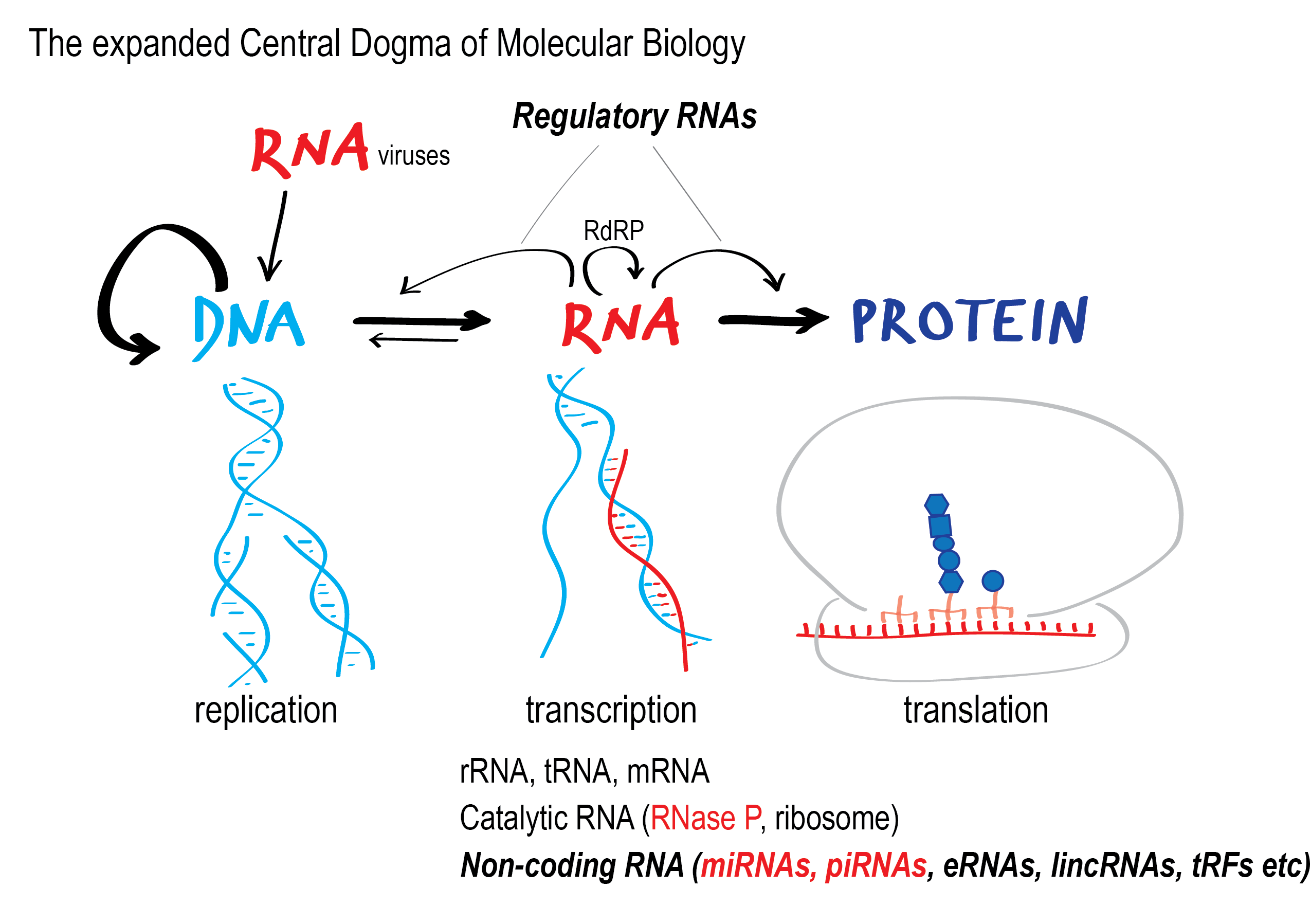
The “Central Dogma of Molecular Biology.” Information flows from DNA to RNA and then is used to make protein.
mRNA vaccines, of course, skip the DNA part, producing an mRNA molecule with all the information necessary for the cell to make the desired protein. But how is that information coded into the DNA and mRNA molecules? DNA and RNA are basically long polymers (chemical chains) made up of four different “bases.” You don’t need to know a lot of the specifics for purposes of this discussion, other than that they are coded A, C, and G in both RNA and DNA; the fourth one used is T in DNA and U (standing for, yes, the dreaded uracil) in RNA, with the two functioning basically the same in each molecule. (Chemists and molecular biologists, I’m simplifying for purposes of a mass audience; no nitpicking.) In the early 1960s, scientists used a clever strategy to work out the genetic code. In brief, they figured out that three nucleotides coded for one amino acid. (As DNA and RNA are chains of a limited number of different bases, proteins are chains made up of amino acids, of which there are 20 used to make the proteins in most organisms. Because, with four different bases, there are more potential combinations of bases in groups of three (64) than there are amino acids, the genetic code is said to be redundant, with most amino acids having more than one three-base “codon” to encode them, although there are special codons that signify the start or termination of translation, all of which were worked out decades ago.
The genetic code is frequently represented as a table like this, with the three letter codes for the amino acids being mapped to the various three-“letter” codon combinations::
Or as a circular diagram like this:
Confession: I included both versions because I think they’re cool.
So what is a frame shift? Think of it this way. To translate the genetic information in an RNA molecule into proteins, a protein complex known as a ribosome slides along the mRNA molecule, adding amino acids to the growing peptide (protein) chain according to its “reading” of the three-letter codons. However, as you can imagine, as accurate as the process of translation is, nothing in nature is absolutely perfect, and sometimes mistakes in translation are made. One type of mistake occurs when for some reason, the “read” of the mRNA template is shifted so that it’s off by a nucleotide base or two. (Note that a frame shift of three bases would bring the ribosome back onto the correct frame to read the rest of the mRNA sequence correctly, although it would result in the deletion or addition of one amino acid.)
I’m going to borrow this example from Wikipedia, because it’s fairly easy to understand:
In this example, the following sequence is a region of the human mitochondrial genome with the two overlapping genes MT-ATP8 and MT-ATP6. When read from the beginning, these codons make sense to a ribosome and can be translated into amino acids (AA) under the vertebrate mitochondrial code:
|Start|AAC GAA AAT CTG TTC GCT TCA ... |Start|123 123 123 123 123 123 123 ... | AA | N E N L F A S ...However, let’s change the reading frame by starting one nucleotide downstream (effectively a “+1 frameshift” when considering the 0 position to be the initial position of A):
A|Start|ACG AAA ATC TGT TCG CTT CA... -|Start|123 123 123 123 123 123 12... | AA | T K I C S L ...Now, because of this +1 frameshifting, the DNA sequence is read differently. The different codon reading frame therefore yields different amino acids.
In the case of a translating ribosome, a frameshift can either result in nonsense (a premature stop codon) after the frameshift, or the creation of a completely new protein after the frameshift. In the case where a frameshift results in nonsense, the NMD (nonsense-mediated mRNA decay) pathway may destroy the mRNA transcript, so frameshifting would serve as a method of regulating the expression level of the associated gene.[5]
Let me just note that frame shifts commonly result in a premature stop codon and, as a result, a much shorter protein, although sometimes the open reading frame (the sequence of RNA without a stop codon) can stretch for considerable length, leading to a much longer different protein being translated. Frame shifts can also occur as a result of a frame shift mutation, which involves the insertion of one or more nucleotides into the sequence of a gene, but that’s not what the paper was examining, as such mutations, being mutations, require modification of the actual nucleotide sequence coding for the proteins. The paper being promoted by antivaxxers concerns itself with frame shifts as a result of the ribosome that do not involve a change in the actual nucleotide sequence.
Now here’s the interesting thing. While it’s true that a ribosomal frame shift can occur as a random “mistake” in the ribosome’s reading of the mRNA sequence, that is far from the only mechanism by which ribosomal frame shifts occur. Indeed, such frame shifts are not uncommon, particularly in viral genomes. They can, for instance, allow for two different proteins to be coded from the same stretch of RNA, transcribed from DNA, thus getting more information out of a much shorter stretch of DNA. Indeed, the Wikipedia article on the topic includes a pretty decent lay summary several types of these naturally-occurring frameshifts, some caused by so-called “slippery sequences” that can make the ribosome “slip” and skip a nucleotide in its reading, with such sequences controlling the rate at which such frame shifting occurs. Also, the secondary structure (how the mRNA loops and folds on itself) can regulate the rate and chance of ribosomal frame shifting.
Can I just say that biology is so cool?
It’s even cooler than that, though. We’ve known a long time that frame shifting is important in coronaviruses and since at least 2005 that there is programmed ribosomal frame shifting in the original SARS viral genome. which makes it no surprise that programmed ribosomal frame shifting might occur SARS-CoV-2. In fact, we know that coronaviiruses require ribosomal frame shifting as part of its replication cycle and that “modified” mRNA bases are not “unnatural”:
This modification naturally occurs in our own ribosomal RNA. RNA has to be modified to prevent triggering of an antiviral immune response that would suppress production of the encoded protein (which would then prevent an effective antibody response):https://t.co/9CovU9rRNK
— Edward Nirenberg 🇺🇦 (@ENirenberg) December 6, 2023
Again, biology is just that cool, and since virology is part of biology it’s so cool too. In fact, frame shifts are important in viruses other than SARS-CoV-2. For instance, as Ed Nirenberg explained while discussing this paper, sometimes the frame-shifted protein product can be as immunogenic (or even more so) than the regular protein product:
For example, it was recently shown that influenza can produce a unique protein product through a frameshift that is very strongly recognized by killer T cells: https://t.co/abJiGB9xjP
This resulting frameshifted product might have an important role in protection from flu.— Edward Nirenberg 🇺🇦 (@ENirenberg) December 6, 2023
But, antivaxxers might ask, isn’t something (like adding pseudouridine to mRNA) that increases the likelihood of ribosomal frame shifting a bad thing? The answer is: It depends. It might be. Certainly, in therapeutics we strive to produce exactly the protein intended, no more, no less. However, that doesn’t mean that the findings of this study are evidence that mRNA-based COVID-19 vaccines are “dunking up” your cells and causing all sorts of random harmful immune reactions, as antivaxxers are claiming. Now that you have some idea of what this form of frame shifting is and know that it’s also not the horribly “unnatural” thing that antivaxxers is trying to portray it as based on this study, let’s look at the study itself.
Pseudouridine and frame shifting in COVID-19 vaccines
Let’s circle back to the actual study, N1-methylpseudouridylation of mRNA causes +1 ribosomal frameshifting. The corresponding author is Anne Willis, who, along with first author Thomas Mulroney and several of the other authors, is based at the MRC Toxicology Unit, University of Cambridge, Cambridge, UK. Other authors are based at Oxford University, University College Dublin, University of Liverpool, University of Kent, and Mahidol University in Thailand. Early on, the authors note that the purpose of their study was to quantify how synthetic nucleotides might affect the fidelity of translation in order to use that information to design better mRNA therapeutics and vaccines, noting early on:
At present, it is unclear which modified ribonucleotides affect mRNA translation fidelity and existing studies are mostly limited to understanding misreading frequencies only at a given codon. Misreading of mRNA codons is also only one type of post-transcriptional mechanism that can alter a polypeptide sequence. So far, no study has investigated the fundamental question of whether modified ribonucleotides can affect the maintenance of the correct reading frame during translation of a synthetic transcript. Understanding these processes is critical to increase our knowledge of protein synthesis from modified mRNAs in general, but is also imperative for the robust design and evaluation of new mRNA-based therapeutics that make use of modified ribonucleotides within widely differing RNA sequences or therapeutic contexts.
Just for completeness’ sake, I like to point out that COVID-19 mRNA-based vaccines incorporate N1-methyl-pseudouridine, and that the discovery that the use of this modified base could greatly decrease the immune response to the mRNA itself as well as result in more robust protein production was critical to the development of current mRNA-based vaccine technology. Now let’s look at what Mulroney et al did.
First, they used a sequence unrelated to the spike sequence used to produce mRNA vaccines, namely a sequence designed to produce the enzyme luciferase. Luciferase is a hellaciously useful enzyme in molecular biology because when the appropriate reagents are provided it produces light by luminescence that can be quantified and is proportional to the amount of luciferase present. That’s why it’s often used as a “reporter gene” placed next to various promoters. In any event, the authors did something fairly clever. I’m not going to go into as much detail as Ed did, but basically they engineered a modified sequence for luciferase consisting of one part of it (the N-terminal domain, labeled NFluc for n-terminal firefly luciferase) that is noncatalytic, attached to CFluc, denoting the part of the protein that catalyzes the light-producing reaction. Now here’s the trick. The sequence is engineered such that the CFluc will be made only if there is a +1 frameshift. No frameshift, no light produced, as the protein will be nonfunctional. Here’s what the constructs look like, compared to wild type (WT, or naturally occurring) full length luciverase:

Note that the CFluc requires a frameshift to occur for it to be made in a form that can catalyze the luciferase reaction.
Basically, Fluc+1FS mRNAs are designed to produce catalytically inactive (truncated) NFluc when translated normally. Clever, right? Then, the investigators made two different versions of this construct, one with just regular mRNA bases (designated unmodified) and one with the 1-methyl-pseudouridine modification used in mRNA vaccines (designated 1-methylΨ, or m1Ψ. Several different other modified uridine bases were used as additional controls. The same thing was done with wild type luciferase:
Panel b shows the luciferase activity as a result of in vitro translation of the wild type luciferase sequence containing either unmodified uracil bases or the modifications listed. As you can see, the m1Ψ modification produces roughly comparable amounts of protein. Panel c, however, shows the same experiment done with Fluc+1FS, which resulted in luciferase activity only from in vitro translation using the m1Ψ-modified mRNA, with minimal activity produced by all the other groups. Panel d represents introducing Fluc+1FS into cells either unmodified or with the m1Ψ modification, and as you can see the m1Ψ-modified mRNA produced a lot more luciferase activity, indicating that the methyl-pseudouridine substitution increased the rate of frame shifting. Finally, e a Western blot, which shows two additional for the m1ψ mRNA, but also a large amount of the expected iin-frame product.
Ed notes:
This broadly agrees with work from 2015 that showed that there is markedly enhanced protein production from m1ψ RNA. https://t.co/nAXriufpAE
This is, fundamentally, the point of using the modification: you want faithful production of your protein inside actual cells.— Edward Nirenberg 🇺🇦 (@ENirenberg) December 6, 2023
So, thus far this paper recapitulates what is already known about Ψ-modified mRNA but also describes increased frame shifting. Sounds bad, right? Well, maybe, or maybe not. In any case, the conclusions thus far are:
Incorporation of 1-methylΨ in Fluc+1FS mRNA significantly increased ribosomal +1 frameshifting to about 8% of the corresponding in-frame protein, which was not observed for other ribonucleotides (Fig. 1c). HeLa cells transfected with 1-methylΨ Fluc+1FS mRNA recapitulated the results from in vitro translation (Fig. 1d). On the basis of these observations, we concluded that IVT mRNA containing 1-methylΨ or 5-methylC exhibits similar translation efficiency to unmodified mRNA, but 1-methylΨ significantly increases ribosomal +1 frameshifting during mRNA translation.
The authors next asked if this phenomenon happens in COVID-19 vaccines. So they vaccinated mice with the Pfizer vaccine and with the Oxford/AZ vaccine, which is DNA-based, not mRNA-based, and therefore would not be expected to produce extraneous proteins due to frame shifts, and looked at T-cell mediated immune responses to spike protein and to the out-of-frame peptides predicted from the nucleotide sequence of spike. What they found was this:
The results are quite interesting. The mice did indeed show an immune response to out-of-frame peptides predicted to be produced by the Pfizer vaccine, while, as expected, the AZ vaccine produced no such response because it couldn’t produce the out-of-frame peptides. However, look at 2c. The Pfizer vaccine produced a greater immune response to the intended antigen, the SARS-CoV2 spike protein, than produced by the AZ vaccine.
Then they did the same thing in humans, examining responses in the peripheral blood monocytes (PBMCs) of 21 individuals vaccinated with BNT162b2 (Pfizer) and compared these responses to those of 20 individuals vaccinated with ChAdOx1 nCoV-19 (AZ):
Panel d assays T-cell immune response PBMCs (IFNγ ELISpot) harvested from human volunteers and stimulated with predicted out-of-frame spike peptides, while panel e shows the same response to in-frame spike peptides: total spike pool or spike S1 + S2 subpools (spike protein S1 and S2 regions). The bottom line is that frame shifting was observed in humans, but it varied between individuals…by a lot. The authors then went on to identify “slippery sites” within the mRNA that are prone to frame shifting and showed that abolishing these sites by mutating them to a different codon coding for the same amino acid could greatly decrease the rate of frame shifting.
Now, I know what antivaxxers are thinking: Maybe these individuals with a greater propensity for their ribosomes to frame shift are those “sensitive” to “vaccine injury” by this mechanism. When it comes to this sort of argument, I tend to agree with Ed Nirenberg (again) that these results have little or no bearing on the safety of the Pfizer vaccine (or the Moderna vaccine) for the reasons that he cites, including:
The sequences of Pfizer and Moderna differ significantly at the nucleotide level, but the nature of the responses and their safety profile is broadly similar, arguing against frameshift products in either case having a meaningful effect.
— Edward Nirenberg 🇺🇦 (@ENirenberg) December 6, 2023
This is very important. Even though the authors did not test the Moderna vaccine, we would expect that, if frame shifting impacted vaccine safety a lot, there would be a significant difference between the two vaccines based on their different nucleotide sequences. That’s not to say that these results don’t matter for future vaccine design. They do, as Ed points out:
The sequences of Pfizer and Moderna differ significantly at the nucleotide level, but the nature of the responses and their safety profile is broadly similar, arguing against frameshift products in either case having a meaningful effect.
— Edward Nirenberg 🇺🇦 (@ENirenberg) December 6, 2023
it’s not likely that it matters much here either way. The authors are (correctly) explicit here that there is no evidence of this contributing to any kind of safety issues with the mRNA vaccines.
Some clueless people claim that this somehow means there's a heightened…
— Edward Nirenberg 🇺🇦 (@ENirenberg) December 6, 2023
In particular, because there is no autoimmune signature for the mRNA-based vaccines:
We in fact see that in stark contrast to COVID-19, there is no autoimmune signature for mRNA vaccines: https://t.co/3GrD9ohfBl
So, basically: a useful study but not good cause to worry about mRNA vaccines.
— Edward Nirenberg 🇺🇦 (@ENirenberg) December 6, 2023
And here is another reason why you shouldn’t worry about these results:
We know that, because authorities like the FDA and EMA have checked this, and independent scientists have done the same.https://t.co/1RCi7SaI4k
2/4
— Marc Veldhoen (@Marc_Veld) December 6, 2023
The sequence is, as always flanked by untranslated parts (UTRs) that are there for stability. And no, of course not, there are no other proteins coded behind this. That is made up. The frameshift itself causes parts to be mistranslated. Not proteins of any use. That is all.
4/4 pic.twitter.com/GicE8khDxg— Marc Veldhoen (@Marc_Veld) December 6, 2023
The protein will start with Spike, and at a few critical points may make a frameshift. This may add some extra amino acids but does not result in much, frequently hitting another translational stop codon, terminating any further protein production. pic.twitter.com/O4qDi2rLA4
— Marc Veldhoen (@Marc_Veld) December 7, 2023
Which is what I said at the beginning of this post—remember?—about how most frame shifts don’t result in much of a protein because it’s usually not too far from the frame shift to a stop codon that will truncate the frame shift peptide after a fairly short sequence. Yes, these short frame shift proteins can—and apparently do—provoke an immune response, but not one that has been demonstrated to cause harm, the ravings of antivaxxers notwithstanding.
Not that this stops antivaxxers like one whom we’ve met before, Joomi Kim, from ranting:
Technically it’s true that there are “no adverse outcomes reported” from the mistranslation of mRNA vaccines, but that’s because we don’t even know what that would look like. Does anyone walk into the ER and say “I experienced a ribosomal frameshift?”1
No one knows what that would look like, and the authors of the paper don’t either.
All the authors can say is that they didn’t see any obvious evidence of harm in the (8?) mice they vaccinated with the Pfizer vax. And even that is iffy: after all, they only looked at what happened to the mice in the short term.
There is only one appropriate reaction to that remark about having “experienced a ribosomal frameshift”:

I just saw Godzilla Minus One this weekend; so this is the only facepalm meme that I could use for this. BTW, Godzilla Minus One is a really great movie, not just a great Godzilla or monster movie, but a great movie, period.
Actually, we do know what such adverse outcomes would probably look like. It would likely look the same as any other errant immune reaction or autoimmune condition.
Unsurprisingly, Kim also pulls the pharma shill gambit:
We should also mention that it’s possible that some of the authors of this paper have some conflicts of interest:
Competing interests
T.E.M. and A.E.W. are inventors on a pending patent application (2305297.0) related to mRNA technology.
The funny thing is, I could argue coming from the opposite view that that such a financial conflict of interest could be a reason why they published findings that demonstrate what they believe to be a deficiency in its design, and then to mention their preferred solution. If I really wanted to be snarky, I could ask them why they didn’t think that Andrew Wakefield had a hopeless conflict of interest, given that when he published his case series he had under development a measles vaccine of his own. Of course, these authors are nothing like Wakefield, in particular because they are very up-front about what they are trying to accomplish:
Although there is no evidence that frameshifted products in humans generated from BNT162b2 vaccination are associated with adverse outcomes, for future use of mRNA technology it is important that mRNA sequence design is modified to reduce ribosome frameshifting events, as this may limit its future use for applications that require higher doses or more frequent dosing, such as the in vivo production of hormones. It is important to continue investigating therapeutic mRNA mistranslation and immunogenicity, as the evolution of antibody and cytolytic T cell responses against +1 frameshifted spike variants and peptides has not been systematically evaluated in humans and ELISpot responses obtained from pooled peptides may also underestimate T cell responses.
And:
Taken together, these data suggest that N1-methylpseudouridylation at defined mRNA sequences triggers ribosome +1 frameshifting; however, with appropriate mRNA sequence design, it is possible to ameliorate this issue.
Which, I note, would be a good thing. Probably. After all, remember that the Pfizer vaccine induced a stronger immune response than the DNA-based vaccine. What if this is in part due to its producing a small amount of frameshift peptides along with its spike protein? The good thing is that this line of research will answer that question, too; so we’ll know.
Finally:
Our mechanistic data are supported by previous observations of ribosomal frameshifting during translation of naturally occurring mRNAs, which implicate ribosome stalling and require ribosome slippery sequences for +1 frameshifting21,26,27,28,33,34. These findings are of particular importance to our fundamental understanding of how ribonucleotide modification affects mRNA translation, and for designing and optimizing future mRNA-based therapeutics to avoid mistranslation events that may decrease efficacy or increase toxicity.
Presumably, the mRNA products and vaccines for which the two main authors have filed a patent application use these findings to produce more effective—and hopefully even safer than the already very safe mRNA-based COVID-19 vaccines—mRNA-based therapeutics and vaccines.
As for the antivaxxers pointing to this study as some sort of slam-dunk evidence of horrific biological and immune effects from small quantities of frameshift peptides generated by the Pfizer (and, presumably, Moderna) vaccines, all I can say is: Thanks for giving me the opportunity to delve into some pretty cool science that, regardless of where it ultimately goes, will likely help us design even better and safer future mRNA-based vaccines and therapeutics that you will hate and try to portray as deadly.


